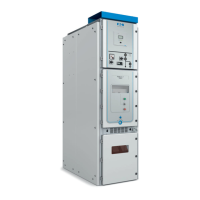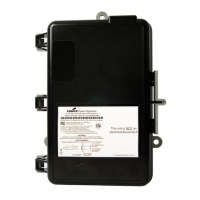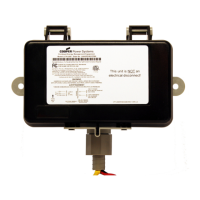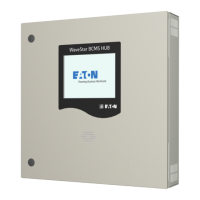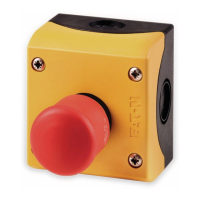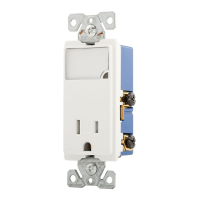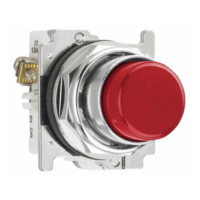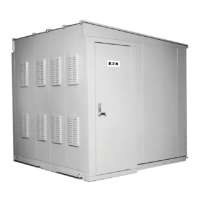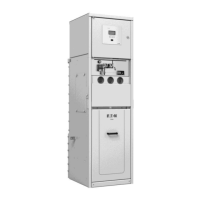18
Instruction Manual IM01500001E
Effective July 2011
Pow-R-Line switchboards
EATON CORPORATION www.eaton.com
Overcurrent devices
Maintenance instructions and field-testing for overcurrent devices
are included with the instruction leaflet for each device within a family.
One instruction leaflet per frame or family type was included with
this installation booklet inside the switchboard. Refer to the leaflet
on each device. If leaflets are missing, contact Eaton for replacement.
Circuit breakers
Visually inspect circuit breakers for signs of discoloration, cracking,
scorching, overheating, or broken parts. Exercise the breaker operating
mechanism, making sure it is opening and closing. A breaker show-
ing signs of any one of these issues should be replaced. Refer to
NEMA publication AB-4, Guidelines for Inspection and Preventative
Maintenance of Molded-Case Circuit Breakers Used in Commercial
and Industrial Applications.
Fusible overcurrent devices
Visually inspect the switching mechanism and fuse connections.
Visually inspect the fusible devices for signs of discoloration, cracking,
scorching, overheating, or broken parts. Replace any worn parts or
the entire switch.
Fuse replacement
DANGER
HAZARDOUS VOLTAGE WILL CAUSE SEVERE INJURY OR DEATH.
DE-ENERGIZE BOARD PRIOR TO SERVICING FUSIBLE DEVICES.
Be sure the switch mechanism is turned to the OFF position before
attempting to remove fuses. Visually inspect the switch contacts,
blades, and mechanism to ensure that the mechanism is in the
OPEN/OFF position.
Check fuses to ensure that they are of the proper class, ampere,
voltage, and interrupting rating. Ensure that non–current-limiting
fuses are not used as replacements for current limiting fuses.
Never attempt to defeat rejection mechanisms which are provided
to prevent the installation of the incorrect class of fuse.
Meters, controllers, surge equipment, and other devices
Individual devices should be maintained according to the specific
instructions supplied for each device. Remove dust and dirt from
exterior with a dry lint-free cloth. Unless specifically instructed in the
individual device instruction leaflet, do not attempt to open sealed
cases or containers.
WARNING
NEVER USE COMPRESSED AIR TO CLEAN OR BLOW OUT DEBRIS OR DUST
IN SWITCHBOARDS.
Secondary wiring
Check all wiring connections for tightness, including those at the
current and potential transformers, if present, and at all terminal
blocks. Check all secondary wiring connections to ensure that
they are properly connected to the switchboard ground bus,
where indicated. Look for broken wire strands and pinched or
damaged insulation.
Ventilation
Check all grills and ventilation ports for obstructions and accumula-
tions of dirt. Clean ventilation ports, if necessary. For switchboards
installed outdoors, inspect the air space under the switchboard to be
sure that it is clean and clear of debris, leaves, and obstructions.
Records
It is essential to maintain the equipment in satisfactory condition.
Maintain a permanent record of all maintenance activities and
testing for future reference. (See Appendix B.)
The condition of each switchboard should be recorded as a guide for
anticipating the need for any replacement parts or components or
special attention at the next regular maintenance period. It is recom-
mended that a series of inspections be made at quarterly intervals
until the progressive effects of local conditions can be analyzed to
determine a regular schedule.
Switchboard events and service interruptions
Short-circuits, ground faults, and overloads
WARNING
DO NOT ATTEMPT TO RE-ENERGIZE SWITCHBOARD OVERCURRENT
DEVICES AFTER ELECTRICAL EVENTS, SUCH AS SHORT CIRCUITS, GROUND
FAULTS, AND OVERLOADS, UNTIL THE CAUSE OF THE EVENT HAS BEEN
IDENTIFIED AND CORRECTED.
A thorough assessment, identification, and correction of the
event origin must be completed. An additional assessment of the
conductor insulation and other insulating materials should be made.
Replace all damaged insulation materials, conductors, and over-
current devices. Original switchboard parts, insulators, insulation
material, and overcurrent devices must be replaced with renewal
parts from Eaton. (See Renewal parts, page 19.)
Do not attempt to re-energize switchboard overcurrent
components after electrical events, such as short circuits,
ground faults, and overloads, until the cause of the event
has been identified and corrected.
After the event has been rectified, test equipment per the
maintenance process described in this publication.
Physical damage
Any physical damage to the switchboard that occurs after the
switchboard is installed must be corrected. A thorough inspection,
which includes the exterior enclosure and deadfront, plus interior
components in the damaged portion of the switchboard, should be
conducted. Replace all damaged parts and components. Ensure that
there are no gaps in the switchboard enclosure that could cause
exposure to live parts. Contact Eaton for renewal parts and assistance.
After the physical damage has been corrected, test equipment per
the maintenance process described in this publication.

